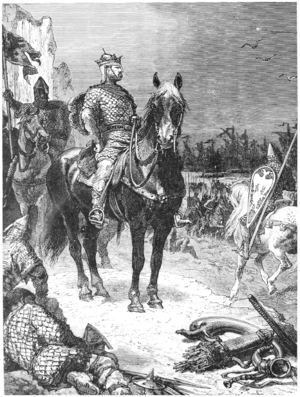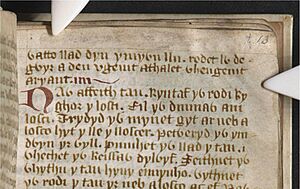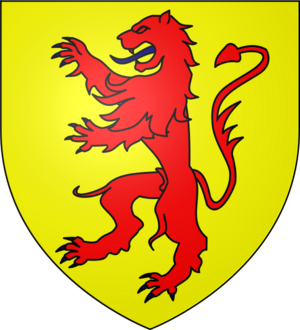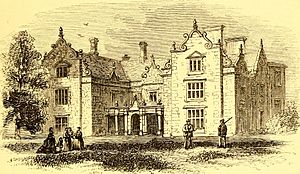Bleddyn ap Cynfyn facts for kids
Quick facts for kids Bleddyn (Blevins)ap Cynfyn |
|
|---|---|
| King of Powys (also Gwynedd) "Chiefest of the Britons" | |
| Died | 1075 |
| Spouse | Haer ferch Gillyn |
| Father | Cynfyn ap Gwerystan |
| Mother | Angharad ferch Maredudd ap Owain |
Bleddyn ap Cynfyn (died 1075) was an important Welsh king in the 11th century. He became a powerful ruler in Wales.
In 1063, King Harold Godwinson and his brother Tostig helped Bleddyn and his brother Rhiwallon become co-rulers of Gwynedd. This happened after their half-brother, King Gruffydd ap Llywelyn, died. Bleddyn also became king of Powys. He ruled Powys and Gwynedd with Rhiwallon until 1075. His family, known as the House of Mathrafal, continued to rule Powys for many years.
Who Was Bleddyn ap Cynfyn?
Bleddyn was the son of a nobleman from Powys named Cynfyn ap Gwerystan. His mother was Angharad. She was the daughter of King Maredudd ab Owain of Dyfed.
Angharad had been married before. Her first husband was Llywelyn ap Seisyll. With him, she had a son named Gruffydd ap Llywelyn. This made Gruffydd Bleddyn's older half-brother.
Bleddyn and his brother Rhiwallon were likely born in the late 1020s. Bleddyn probably lived in Powys. There, he married a woman named Haer ferch Cillyn. Her father was a local lord.
Bleddyn's Time as King

Gruffydd ap Llywelyn became very powerful. He was a threat to King Harold Godwinson of England. After Gruffydd died in 1063, Harold and his brother Tostig took control of Wales.
They gave the southern parts of Wales back to their old ruling families. But they made Bleddyn and Rhiwallon kings of Powys and Gwynedd. The brothers promised to be loyal to King Harold and Edward the Confessor.
When William the Conqueror invaded England in 1066, Bleddyn was the strongest king in Wales. He was a close friend of King Harold. So, Bleddyn and Rhiwallon joined the English in fighting William.
In 1067, they helped a leader named Eadric the Wild. They attacked the Normans near Hereford. In 1068, they also joined other English earls in their fights.
In 1070, Gruffydd's sons, Idwal and Maredudd, challenged Bleddyn. In a battle called the Battle of Mechain, Rhiwallon, Idwal, and Maredudd all died. After this, Bleddyn became the sole king of both Gwynedd and Powys.
In 1073, a Norman lord named Robert of Rhuddlan tried to capture Bleddyn. He failed but stole many valuable things. Bleddyn was killed in 1075 by Rhys ab Owain, the king of Deheubarth. Some local lords had betrayed Bleddyn.
Later, Rhys ab Owain was defeated in battle. He was then killed by Caradog ap Gruffydd. Many people saw this as revenge for Bleddyn's death. After Bleddyn died, Gwynedd was taken over by Trahaearn ap Caradog. But in Powys, Bleddyn's family continued to rule for over 200 years.
Bleddyn's Important Legacy

The old Welsh book, Chronicle of the Princes, described Bleddyn as a very good ruler. It said he was:
- "The most lovable and most merciful of all kings."
- "Kind to his family."
- "Generous to the poor."
- "Merciful to travelers, orphans, and widows."
- "A protector of the weak."
- "Gentle and kind."
- "He did not harm anyone unless he was insulted."
- "Generous to everyone, brave in war, but loved in peace."
Bleddyn also updated the Welsh law. These new laws were used in his kingdom of Powys. For example, he changed how the size of a homestead (a family's home and land) was measured for inheritance. The size depended on the owner's social status. A nobleman's homestead was 12 Welsh acres. A serf's (a farmer tied to the land) was 8 acres. A bondsman's (a servant or slave) was 4 acres. However, the law often said it was 4 acres for everyone.
Bleddyn's Children
Bleddyn had at least five children:



